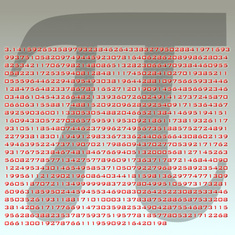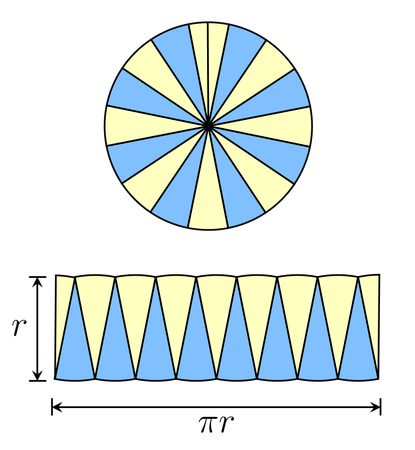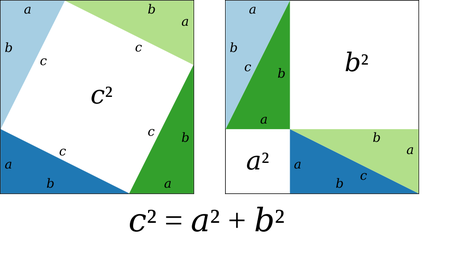
Some Cool Mathematical Proofs
Last updated: Wednesday November 24th, 2021
Report this blog
Introduction
I've been fascinated with math for as long as I can remember. There's something about it that just interests me and it's always been that way. Because of this, I've come to be pretty good at math throughout the years and when you learn enough in the math field, you start to wonder where things come from.
All throughout school you're taught things like the area of a circle is πr2, the value of π is approximately 3.14, tan(x)=sin(x)/cos(x), and many other formulas or values that we usually just take for granted. Obviously, some mathematician in history had to come up with these formulas or else we wouldn't have them today, and in order to "create" a formula and make it commonplace in math, you have to prove it. This blog will be going over some of the ways to prove some of your favorite mathematical concepts.
Definitions and Descriptions
Now I realize that many of you here haven't progressed in math far enough to know what a proof is. I learned about them for the first time in 10th grade geometry for me if I remember right.
A proof is exactly what it sounds like: a mathematical argument that uses logic to guarantee the conclusion. In other words, it is just a way to prove something is correct.
Radius - The distance from the center of a circle to its perimeter.
Circumference - The perimeter of a circle.
Leg [of a triangle] - One of the sides that meet to form a right angle in a triangle.
Transitive property - A property which states that if x=y and y=z, then x=z
Area of a Circle
I don't even remember when I learned the formula for calculating the area of a circle. Most of you know this formula as πr2 where π is an irrational constant approximately equal to 3.1416 and r is the radius of said circle. Most of this use this formula without thinking about it but where did it really come from?
In the fifth century B.C, a Greek mathematician named Eudoxus discovered that the area of a circle is proportional to its radius squared. The proportional constant that you would use to calculate this, by the way, is π, which is the circumference of any circle divided by its diameter. Archimedes is said to have come up with the formula even though π wasn't even completely accurate at his time. Back then, mathematicians used approximations for π like 22/7 which equals an incredibly accurate 3.1428.
There are various ways to prove A=πr2, but my personal favorite uses geometry and is surprisingly simple.

This proof involves splitting a circle into a huge amount of slices, an infinite amount if you want to be precise. The depiction above is heavily simplified, but still does a great job at visualizing the proof.
We know that the circumference of a circle is 2πr or πd where d is diameter. This comes from the fact that π, as stated previously, is the value equal to a circle's circumference over its diameter. Using algebra we can determine:
π=C/D
π=C/2r | Diameter is two times radius by definition
2πr=C | Simple algebra (multiply both sides by 2r)
The diagram shows splitting the circle into slices of two different colors. It is important to know that both colors have an equal area. The second image shows a rearrangement of the slices into a rectangle. You may notice that it is not a perfect rectangle because of the curves on each slice. This doesn't discredit the proof. Ideally, we would want to split this circle into an infinite amount of slices. Of course that isn't possible to show in an image and to even understand it would require a knowledge of integral calculus, so we are going to shy away from that for now. All you need to know is that as the slices get smaller, it becomes more rectangular.
In the rectangular rearrangement, you could say that the top and bottom side both contain half the circumference. Because we know that the total circumference is 2πr, we can say that the length of one side (top or bottom) is 1/2 times 2πr or simply just πr.
As for the shorter side, we know that each slice has a point at the very center of the circle and extends to the edge. By definition, the length of a slice then is the radius.
If we know the formula to find the area of a rectangle, which luckily I think I have it figured out, we can approximate the area of this circle. The area of a rectangle is length times width, or as I like to say it, base times height. The length of the base of this rectangle, as stated above, is πr. The height, also stated above, is equal to r or the radius. Using simple algebra we can conclude that the area of the rectangle is equal to πr*r or as we like to say, πr2.
It's important to note that the area of the rectangle is exactly equal to the area of the circle. No area was added or removed from the circle when transforming it into a rectangle.
So that's pretty cool, right? πr2 isn't actually some made up formula or an approximation; it is a way to perfectly calculate the area of any circle.
Pythagorean Theorem
There's a good chance you know this formula too. I've heard some people joke about the Pythagorean theorem, saying "when will I ever need to know this in real life?" I can say that the Pythagorean theorem is one of the most important formulas to know in math and life in general especially if you're going into engineering.
The Pythagorean theorem is a2+b2=c2 where a and b are the legs of a right triangle and c is the hypotenuse. The theorem while named after Pythagoras, an Ancient Greek mathematician born around 570 B.C, was actually first discovered thousands of years before him. It is said to have first been discovered by the Babylonians in the 20th century B.C -- around 4,000 years ago! Nearly every ancient civilization discovered the theorem at some point in time. The reason it's named after Pythagoras is because he was probably the first to use it mathematically instead of architecturally.
Once again, there are various ways to prove Pythagoras' theorem. My favorite is once again a simple diagram.

At first this image is a lot to take in, but let's take a moment to decipher it.
The left image is what we are going to focus on first. We are going to let the long leg of the triangle equal b, the short leg equal a, and the hypotenuse equal c. We lay four identical triangles around in a square as shown above. Note that the white area in the middle is equal to c2 because all four of its sides are equal to c. One side of the larger square is equal to a+b, so the area of the larger square can be written as (a+b)2. Using FOIL, we can determine that (a+b)2 is equal to a2+2ab+b2. So we know that the area of the large outer square is equal to a2+2ab+b2.
In order to complete the proof, we need to know how to find the area of a triangle. Anyone who's made it past 5th grade math knows that the formula for that is (1/2)bh where b is base and h is height. Using this formula we can find the area of one of the colored triangles: (1/2)ab. We can observe that there are four of these colored triangles inside the larger square so the total area of the colored portion is 4 times the area of one of the triangles which totals out at 2ab.
So if the area of the large square is a2+2ab+b2 and the area that is colored is 2ab. We can determine the area of the white square in the middle, simply by subtracting 2ab from a2+2ab+b2. The difference works out to be a2+b2.
To conclude, the white area in the middle, equal to c2, is also equal to a2+b2. We can use the transitive property to tell us that a2+b2=c2.
Conclusion
There are two of my favorite mathematical proofs. There are a lot more that I can think of, so if this is well received, a part two is definitely in the realm of possibility. Also, if I made any mistakes or if you are just confused about something, please leave a comment. If there's one thing I've learned in my many years of math classes, it's that you shouldn't be afraid to ask questions!
Thanks for reading!

Nice one squidpsyco!
It's actually really surprising how much humans were able to figure out thousands of years ago, without all the technology we have today (although, I suppose those calculations were required to get us the calculators we have)!
One small thing: I think you should specify that FOIL is a way of distributing binomials, since some people reading the blog might not have learned about it yet, or been taught differently.
Otherwise, this'll almost definitely appear in the next BG, one way or another!